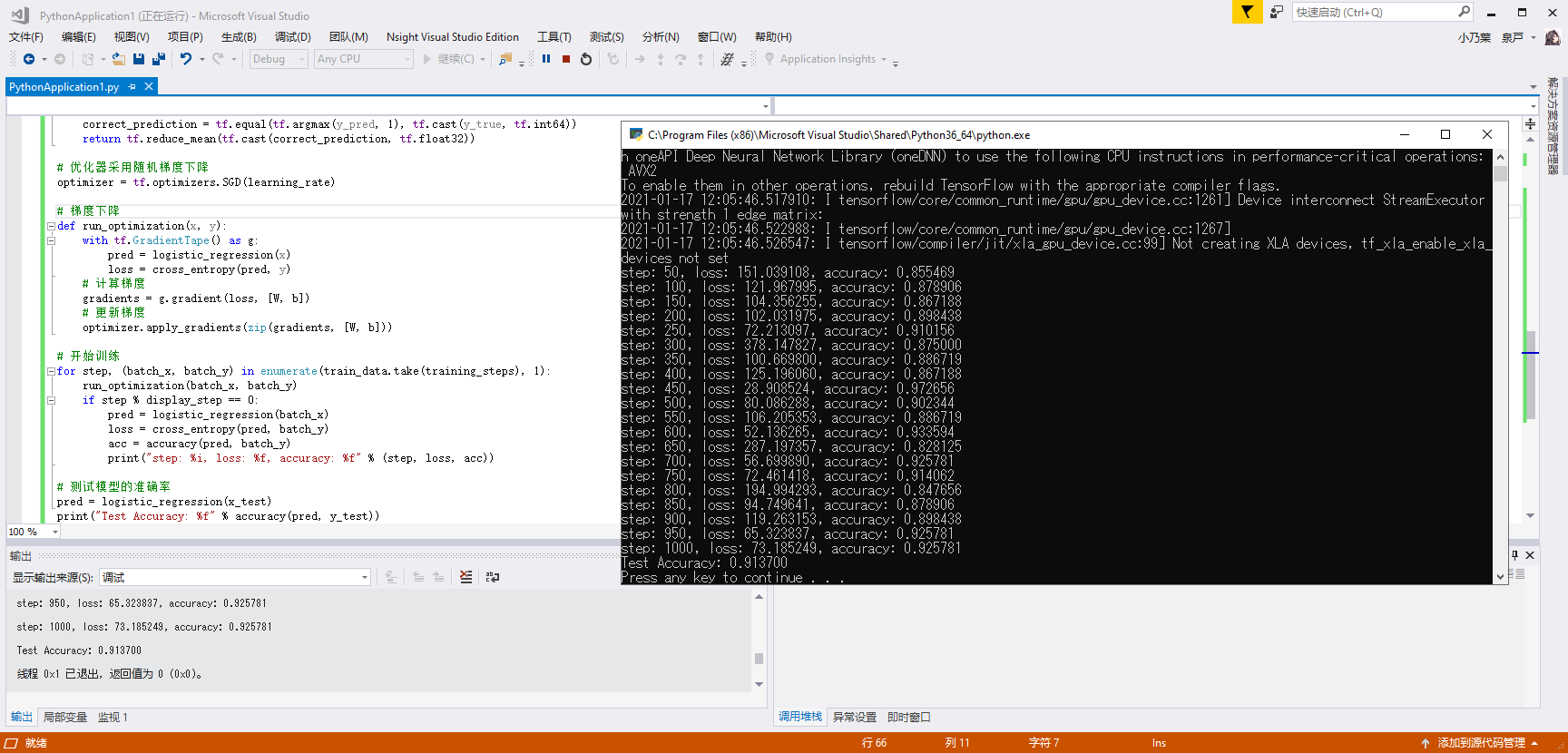今天是看的逻辑回归的案例。和先前一样,由于使用的TF2.0改用了网络上的代码。
同时,虽然代码成功运行,但是逻辑回归算法的原理和很多地方的“为什么这么写”仍然没有弄得很清楚。目前正在参考一篇博客(链接https://blog.csdn.net/weixin_39445556/article/details/83930186)但一时半会仍然没有弄懂。不过这个和先前的线性回归部分都明显体会到了 计算机做事本质是“让计算机解数学题”这一点。
代码如下(来源:https://blog.csdn.net/wardseptember/article/details/101910382)

1 import tensorflow as tf 2 import numpy as np 3 import matplotlib.pyplot as plt 4 5 #import mnist in TF2.0 6 from tensorflow.keras.datasets import mnist 7 8 #Disable TF2 behavior 9 #tf.disable_v2_behavior() 10 #Disable executing eagerly 11 #tf.compat.v1.disable_eager_execution(); 12 #check whether the executing eagerly is Enabled 13 tf.executing_eagerly(); 14 15 #VALUE 16 #MNIST 17 num_classes = 10 18 num_features = 784 19 #train 20 learning_rate = 0.01 21 training_steps = 1000 22 batch_size = 256 23 display_step = 50 24 25 #primary Code(s) starts here 26 # 预处理数据集 27 (x_train, y_train), (x_test, y_test) = mnist.load_data() 28 # 转为float32 29 x_train, x_test = np.array(x_train, np.float32), np.array(x_test, np.float32) 30 # 转为一维向量 31 x_train, x_test = x_train.reshape([-1, num_features]), x_test.reshape([-1, num_features]) 32 # [0, 255] 到 [0, 1] 33 x_train, x_test = x_train / 255, x_test / 255 34 35 # tf.data.Dataset.from_tensor_slices 是使用x_train, y_train构建数据集 36 train_data = tf.data.Dataset.from_tensor_slices((x_train, y_train)) 37 # 将数据集打乱,并设置batch_size大小 38 train_data = train_data.repeat().shuffle(5000).batch(batch_size).prefetch(1) 39 40 # 权重[748, 10],图片大小28*28,类数 41 W = tf.Variable(tf.ones([num_features, num_classes]), name="weight") 42 # 偏置[10],共10类 43 b = tf.Variable(tf.zeros([num_classes]), name="bias") 44 45 # 逻辑回归函数 46 def logistic_regression(x): 47 return tf.nn.softmax(tf.matmul(x, W) + b) 48 49 # 损失函数 50 def cross_entropy(y_pred, y_true): 51 # tf.one_hot()函数的作用是将一个值化为一个概率分布的向量 52 y_true = tf.one_hot(y_true, depth=num_classes) 53 # tf.clip_by_value将y_pred的值控制在1e-9和1.0之间 54 y_pred = tf.clip_by_value(y_pred, 1e-9, 1.0) 55 return tf.reduce_mean(-tf.reduce_sum(y_true * tf.math.log(y_pred))) 56 57 # 计算精度 58 def accuracy(y_pred, y_true): 59 # tf.cast作用是类型转换 60 correct_prediction = tf.equal(tf.argmax(y_pred, 1), tf.cast(y_true, tf.int64)) 61 return tf.reduce_mean(tf.cast(correct_prediction, tf.float32)) 62 63 # 优化器采用随机梯度下降 64 optimizer = tf.optimizers.SGD(learning_rate) 65 66 # 梯度下降 67 def run_optimization(x, y): 68 with tf.GradientTape() as g: 69 pred = logistic_regression(x) 70 loss = cross_entropy(pred, y) 71 # 计算梯度 72 gradients = g.gradient(loss, [W, b]) 73 # 更新梯度 74 optimizer.apply_gradients(zip(gradients, [W, b])) 75 76 # 开始训练 77 for step, (batch_x, batch_y) in enumerate(train_data.take(training_steps), 1): 78 run_optimization(batch_x, batch_y) 79 if step % display_step == 0: 80 pred = logistic_regression(batch_x) 81 loss = cross_entropy(pred, batch_y) 82 acc = accuracy(pred, batch_y) 83 print("step: %i, loss: %f, accuracy: %f" % (step, loss, acc)) 84 85 # 测试模型的准确率 86 pred = logistic_regression(x_test) 87 print("Test Accuracy: %f" % accuracy(pred, y_test))
运行结果如下:

